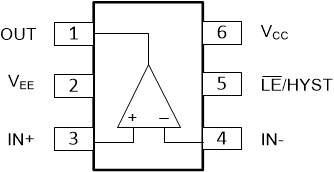SLOK017 June 2024 TLV1H103-SEP
PRODUCTION DATA
4 Test Device and Test Board Information
The TLV1H103-SEP is packaged in a 6-pin, SOT-23 shown with pinout in Figure 4-1.
 Figure 4-1 TLV1H103-SEP Pinout Diagram
Figure 4-1 TLV1H103-SEP Pinout DiagramQualification Devices and Test Board
The TLV1H103-SEP was biased in either an output high or output low condition in single supply, where VCC was set to 5.5V and VEE was set to GND (0V). To achieve an output high state, IN+ was biased with 2V and IN- was biased with 1V. For an output low condition, IN+ was biased with 1V and IN- was biased with 2V. In either cases, the LE/HYST pin was left open. Heavy ions with LETEFF = 48.47 MeV-cm2 / mg were used to irradiate the devices. A nominal flux of 105 ions / s-cm2 and fluence of 107 ions / cm2 were used during the exposure at 125°C.
 Figure 4-2 TLV1H103-SEP Bias Diagram
Figure 4-2 TLV1H103-SEP Bias Diagram Figure 4-3 TLV1H103-SEP Bias Board for SEL Testing.
Figure 4-3 TLV1H103-SEP Bias Board for SEL Testing.